The Cortisol Testing Kits Market is estimated to be valued at USD 208.6 million in 2025 and is projected to reach USD 373.0 million by 2035, registering a compound annual growth rate (CAGR) of 6.0% over the forecast period.
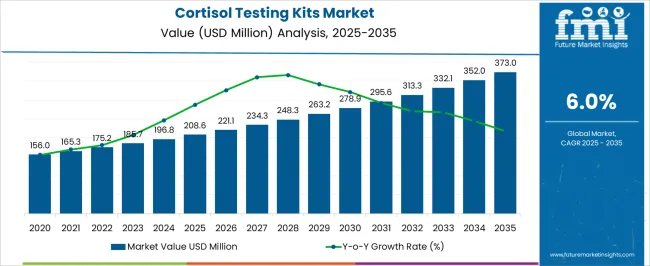
| Metric | Value |
|---|---|
| Cortisol Testing Kits Market Estimated Value in (2025 E) | USD 208.6 million |
| Cortisol Testing Kits Market Forecast Value in (2035 F) | USD 373.0 million |
| Forecast CAGR (2025 to 2035) | 6.0% |
The Cortisol Testing Kits market is witnessing robust growth, driven by the rising demand for accurate and rapid assessment of cortisol levels in clinical and research settings. The increasing prevalence of stress-related disorders, metabolic syndromes, and adrenal dysfunction is creating a critical need for precise diagnostic tools. Adoption is further supported by the growing focus on personalized healthcare and preventive medicine, where monitoring cortisol levels can guide therapeutic interventions and lifestyle modifications.
Advancements in assay technologies, including high-sensitivity detection, automation, and improved reagents, are enhancing test accuracy and reducing turnaround time. The availability of portable and user-friendly kits is expanding adoption in both hospital laboratories and point-of-care settings.
Increasing awareness among healthcare providers and patients about the impact of chronic stress and hormonal imbalances is also driving market growth As clinical research continues to expand into stress physiology and endocrine disorders, cortisol testing kits are expected to see sustained demand, supported by innovations that improve reliability, accessibility, and scalability in diverse healthcare environments.
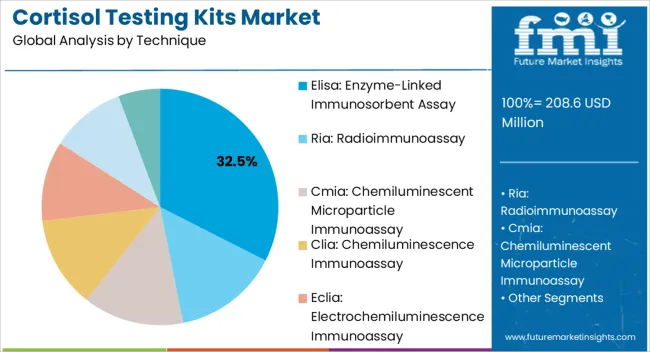
The Elisa: Enzyme-Linked Immunosorbent Assay technique segment is projected to hold 32.5% of the market revenue in 2025, establishing it as the leading technique. Its dominance is driven by the high sensitivity, specificity, and reproducibility offered by Elisa assays, which are critical for accurate cortisol quantification. The technique allows for high-throughput testing in clinical laboratories while providing reliable results in both research and diagnostic applications.
Automation capabilities and standardized protocols reduce operational errors and improve workflow efficiency. The ability to process multiple samples simultaneously and detect low hormone concentrations supports its widespread adoption.
Continuous improvements in reagent quality, assay kits, and detection methods have further strengthened its market position As healthcare providers increasingly require precise and timely cortisol measurements for diagnosis, monitoring, and research purposes, Elisa assays are expected to maintain their leading role, driven by accuracy, reliability, and broad applicability across diverse clinical and laboratory settings.
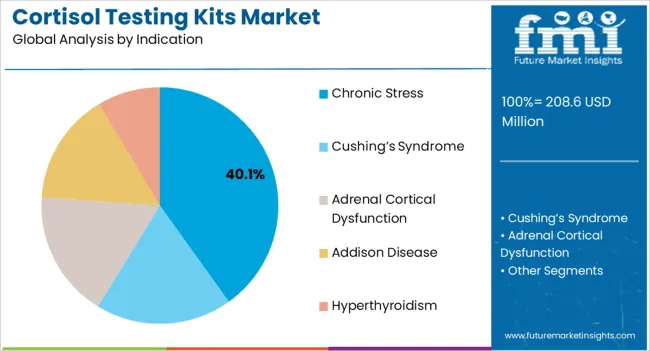
The chronic stress indication segment is anticipated to account for 40.1% of the market revenue in 2025, making it the leading application area. Growth in this segment is being driven by the rising prevalence of stress-related disorders, occupational stress, and lifestyle-induced hormonal imbalances worldwide. Cortisol testing kits enable the quantification of stress biomarkers, assisting clinicians in diagnosing chronic stress and its related physiological impacts.
The ability to provide objective, real-time insights into cortisol fluctuations supports personalized treatment strategies and lifestyle interventions. Increasing awareness among healthcare providers and patients regarding the health consequences of chronic stress is further boosting adoption.
Research advancements in endocrinology and stress physiology have improved understanding of cortisol dynamics, reinforcing the clinical utility of testing kits As monitoring of stress biomarkers becomes a routine component of preventive and therapeutic care, the chronic stress segment is expected to remain the primary driver of market growth, supported by ongoing innovation in testing methodologies and data interpretation.
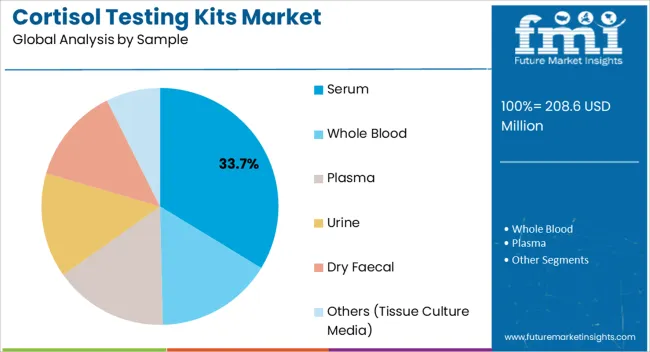
The serum sample segment is projected to hold 33.7% of the market revenue in 2025, establishing it as the leading sample type. Its prominence is being driven by the reliability and reproducibility of serum-based measurements, which provide accurate quantification of circulating cortisol levels. Serum collection is widely accepted in clinical practice, offering a standardized approach for diagnosis and monitoring.
The sample type enables high assay sensitivity and compatibility with multiple testing techniques, including Elisa, chemiluminescence, and immunoassays. Its stability during processing and storage ensures consistent results across laboratory workflows.
Adoption is further supported by routine use in hospitals, diagnostic laboratories, and research institutions for endocrine assessments As precision medicine and preventive healthcare continue to emphasize biomarker monitoring, serum samples are expected to maintain their leading position, offering both operational efficiency and clinically relevant insights into cortisol levels, thereby supporting ongoing market expansion.
From 2020 to 2025, the global cortisol testing kits market experienced a CAGR of 5.1%, reaching a market size of USD 208.6 million in 2025.
From 2020 to 2025, Over the past two decades, there has been a growing recognition of the importance of cortisol testing in diagnosing hormonal disorders such as adrenal insufficiency and Cushing's syndrome. As awareness about these conditions has increased, there has been a corresponding rise in the demand for cortisol testing kits, leading to market growth.
Future Forecast for Cortisol Testing Kits Industry:
Looking ahead, the global cortisol testing kits industry is expected to rise at a CAGR of 6.3% from 2025 to 2035. During the forecast period, the market size is expected to reach USD 373 million by 2035.
The cortisol testing kits industry is expected to continue its growth trajectory from 2025 to 2035, driven by the adoption of remote patient monitoring and telehealth solutions. The integration of cortisol testing kits with digital health solutions, such as smartphone apps and wearable devices, is expected to continue.
These digital tools can facilitate convenient testing, real-time data tracking, and remote monitoring of cortisol levels. The ability to collect and analyze data seamlessly can lead to improved patient management and better healthcare outcomes, driving the growth of cortisol testing kits.
| Country | The United States |
|---|---|
| Market Size (USD million) by End of Forecast Period (2035) | USD 373 million |
| CAGR % 2025 to End of Forecast (2035) | 6.1% |
The cortisol testing kits industry in the United States is expected to reach a market size of USD 373 million by 2035, expanding at a CAGR of 6.1%. Chronic diseases and conditions, such as diabetes, obesity, and cardiovascular diseases, are prevalent in the United States. There is a well-established link between stress and the development or exacerbation of these conditions. Cortisol testing kits play a crucial role in assessing stress levels and monitoring the impact of stress on disease management.
| Country | The United Kingdom |
|---|---|
| Market Size (USD million) by End of Forecast Period (2035) | USD 15.4 million |
| CAGR % 2025 to End of Forecast (2035) | 6.0% |
The cortisol testing kits industry in the United Kingdom is expected to reach a market share of USD 15.4 million, expanding at a CAGR of 6.0% during the forecast period. The United Kingdom has witnessed a shift towards self-care and wellness, with individuals taking a proactive approach to managing their health. Cortisol testing kits offer a convenient and accessible way for individuals to monitor their stress levels at home. The ability to track cortisol levels empowers individuals to make informed lifestyle choices, seek appropriate interventions, and take control of their well-being.
| Country | China |
|---|---|
| Market Size (USD million) by End of Forecast Period (2035) | USD 24.4 million |
| CAGR % 2025 to End of Forecast (2035) | 7.3% |
The cortisol testing kits industry in China is anticipated to reach a market size of USD 24.4 million, moving at a CAGR of 7.3% during the forecast period. Technological advancements in cortisol testing have made the process more accurate, efficient, and user-friendly. Portable and rapid cortisol testing kits enable healthcare providers to obtain immediate results, facilitating timely diagnosis and treatment decisions.
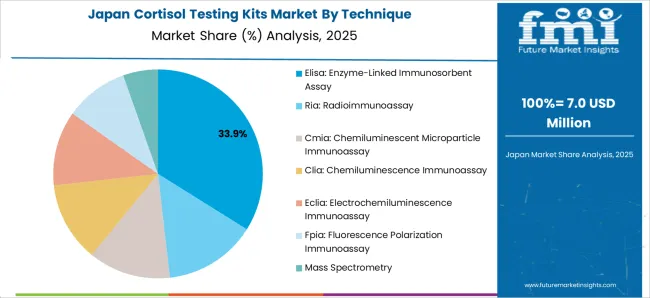
| Country | Japan |
|---|---|
| Market Size (USD million) by End of Forecast Period (2035) | USD 17.8 million |
| CAGR % 2025 to End of Forecast (2035) | 7.2% |
The cortisol testing kits industry in Japan is estimated to reach a market size of USD 17.8 million by 2035, thriving at a CAGR of 7.2%. Collaboration between the medical device industry and healthcare providers is driving the adoption of cortisol testing kits in Japan. Manufacturers and suppliers of cortisol testing kits are working closely with healthcare professionals to develop and promote the use of these kits for stress assessment and management.
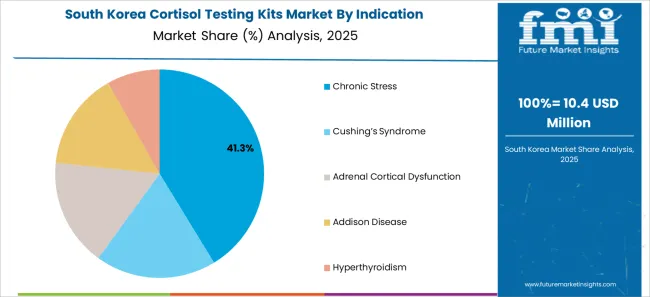
| Country | South Korea |
|---|---|
| Market Size (USD million) by End of Forecast Period (2035) | USD 20.2 million |
| CAGR % 2025 to End of Forecast (2035) | 7.0% |
The cortisol testing kits industry in South Korea is expected to reach a market size of USD 20.2 million, expanding at a CAGR of 7.0% during the forecast period. South Korea has been increasing its healthcare spending, leading to improved access to healthcare services and medical devices. With greater access to healthcare facilities, there is a higher demand for medical devices, including cortisol testing kits, to support diagnosis, monitoring, and treatment. The increased healthcare spending provides opportunities for manufacturers and suppliers of cortisol testing kits to cater to the growing demand.
ELISA is expected to dominate the cortisol testing kits industry with a CAGR of 6.5% from 2025 to 2035. ELISA-based cortisol testing kits offer high sensitivity and specificity, allowing for accurate measurement of cortisol levels in biological samples. These kits have a lower limit of detection that enables the quantification of cortisol even at low concentrations, making them suitable for a wide range of applications.
Hyperthyroidism is expected to dominate the cortisol testing kits industry with a CAGR of 6.4% from 2025 to 2035. Cortisol testing may still have some relevance in cases where hyperthyroidism is suspected to be caused by another condition or is associated with stress-related disorders. In such cases, cortisol testing can help evaluate the impact of stress on the body or assess the function of the adrenal glands, which are involved in cortisol production. This information may complement the overall assessment of a patient with suspected or diagnosed hyperthyroidism.
Whole blood is expected to dominate the cortisol testing kits industry with a CAGR of 6.1% from 2025 to 2035. Cortisol testing kits that utilize whole blood as the sample type are available for measuring cortisol levels. These kits are designed to provide a convenient and rapid method for cortisol analysis in whole blood samples. Whole blood cortisol testing kits are designed to provide rapid results, often within minutes. This quick turnaround time allows for immediate assessment of cortisol levels, enabling timely decision-making and intervention if necessary.
Diagnostics centers is expected to dominate the cortisol testing kits industry with a CAGR of 6.5% from 2025 to 2035. Diagnostics centers can play a significant role in offering cortisol testing services using cortisol testing kits. These centers, equipped with appropriate laboratory facilities and trained personnel, can perform cortisol testing to assess stress levels and aid in the diagnosis and management of certain conditions.
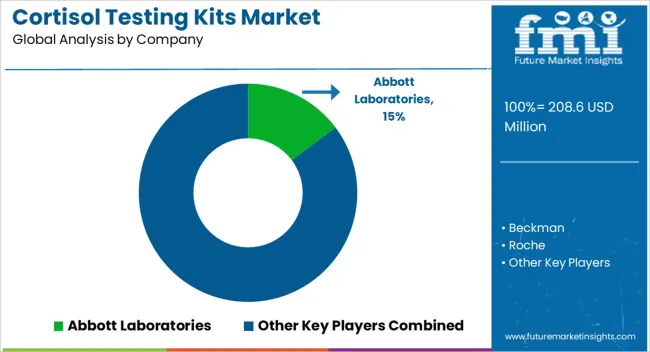
Cortisol testing kits industry is fiercely competitive, with many companies fighting for market dominance. To stay ahead of the competition in such a circumstance, essential players must employ smart techniques.
Key Strategies Used by the Participants
Companies invest heavily in R&D to develop testing kits that improve efficiency, accuracy, and cost-effectiveness. Technology innovation allows businesses to differentiate themselves from their competition while also catering to the changing demands of their consumers.
Key industry leaders frequently develop strategic partnerships and collaborations with other companies in order to harness their strengths and increase their market reach. Companies might also gain access to new technology and markets through such agreements.
Cortisol testing kits industry is expanding rapidly in emerging regions such as China and India. Key firms are enhancing their distribution networks and developing local manufacturing facilities to increase their presence in these areas.
Mergers and acquisitions are frequently used by key players in the cortisol testing kits business to consolidate their market position, extend their product range, and gain access to new markets.
Key Developments in the Cortisol testing kits Market:
The global cortisol testing kits market is estimated to be valued at USD 208.6 million in 2025.
The market size for the cortisol testing kits market is projected to reach USD 373.0 million by 2035.
The cortisol testing kits market is expected to grow at a 6.0% CAGR between 2025 and 2035.
The key product types in cortisol testing kits market are elisa: enzyme-linked immunosorbent assay, ria: radioimmunoassay, cmia: chemiluminescent microparticle immunoassay, clia: chemiluminescence immunoassay, eclia: electrochemiluminescence immunoassay, fpia: fluorescence polarization immunoassay and mass spectrometry.
In terms of indication, chronic stress segment to command 40.1% share in the cortisol testing kits market in 2025.
Explore Similar Insights

Thank you!
You will receive an email from our Business Development Manager. Please be sure to check your SPAM/JUNK folder too.
Chat With
MaRIA